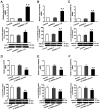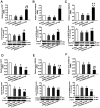Expression levels of the α7 nicotinic acetylcholine receptor in the brains of patients with Alzheimer's disease and their effect on synaptic proteins in SH-SY5Y cells
- PMID: 32582986
- PMCID: PMC7411404
- DOI: 10.3892/mmr.2020.11253
Expression levels of the α7 nicotinic acetylcholine receptor in the brains of patients with Alzheimer's disease and their effect on synaptic proteins in SH-SY5Y cells
Abstract
Alzheimer's disease (AD) is a chronic neurodegenerative, and abnormal aggregation of the neurotoxic β amyloid (Aβ) peptide is an early event in AD. The present study aimed to determine the correlation between the nicotinic acetylcholine receptor α7 subunit (α7 nAChR) and Aβ in the brains of patients with AD, and to investigate whether the increased expression levels of the α7 nAChR could alter the neurotoxicity of Aβ. The expression levels of α7 nAChR and Aβ in the brains of patients with AD and healthy brains were analyzed using immunofluorescence. Moreover, SH‑SY5Y cells were used to stably overexpress or silence α7 nAChR expression levels, prior to the treatment with or without 1 µmol/l Aβ1‑42 oligomer (AβO). The mRNA and protein expression levels of α7 nAChR, synaptophysin (SYP), postsynaptic density of 95 kDa (PSD‑95) and synaptosomal‑associated protein of 25 kDa (SNAP‑25) were subsequently analyzed using reverse transcription‑quantitative PCR and western blotting. In addition, the concentration of acetylcholine (ACh) and the activity of acetylcholinesterase (AChE) were analyzed using spectrophotometry, while the cell apoptotic rate was determined using flow cytometry. The expression of Aβ in the brains of patients with AD was found to be significantly increased, whereas the expression of α7 nAChR was significantly decreased compared with the healthy control group. In vitro, the expression levels of α7 nAChR were significantly increased or decreased following the overexpression or silencing of the gene, respectively. Consistent with these observations, the mRNA and protein expression levels of SYP, PSD‑95 and SNAP‑25 were also significantly increased following the overexpression of α7 nAChR and decreased following the genetic silencing of the receptor. In untransfected or negative control cells, the expression levels of these factors and the apoptotic rate were significantly reduced following the exposure to AβO, which was found to be attenuated by α7 nAChR overexpression, but potentiated by α7 nAChR RNA silencing. However, no significant differences were observed in either the ACh concentration or AChE activity following transfection. Collectively, these findings suggested that α7 nAChR may protect the brains of patients with AD against Aβ, as α7 nAChR overexpression increased the expression levels of SYP, SNAP‑25 and PSD‑95, and attenuated the inhibitory effect of Aβ on the expression of these synaptic proteins and cell apoptosis. Overall, this indicated that α7 nAChR may serve an important neuroprotective role in AD.
Keywords: SH-SY5Y cells; α7 nicotinic acetylcholine receptor; β-amyloid peptide; synaptic protein; synaptophysin; apoptotic rate; synaptosomal-associated protein of 25 kda; postsynaptic density of 95 kda; alzheimer's disease.
Figures






Similar articles
-
[Neuroprotective effects of alpha7 neuronal acetylcholine receptor and its roles in the pathogenesis of Alzheimer's disease].Zhonghua Bing Li Xue Za Zhi. 2008 Jan;37(1):51-5. Zhonghua Bing Li Xue Za Zhi. 2008. PMID: 18509986 Chinese.
-
The consequences of reducing expression of the alpha7 nicotinic receptor by RNA interference and of stimulating its activity with an alpha7 agonist in SH-SY5Y cells indicate that this receptor plays a neuroprotective role in connection with the pathogenesis of Alzheimer's disease.Neurochem Int. 2007 Nov-Dec;51(6-7):377-83. doi: 10.1016/j.neuint.2007.04.002. Epub 2007 Apr 8. Neurochem Int. 2007. PMID: 17493709
-
Temporal changes of CD68 and α7 nicotinic acetylcholine receptor expression in microglia in Alzheimer's disease-like mouse models.J Alzheimers Dis. 2015;44(2):409-23. doi: 10.3233/JAD-141572. J Alzheimers Dis. 2015. PMID: 25352454
-
Alpha 7 nicotinic acetylcholine receptor and its effects on Alzheimer's disease.Neuropeptides. 2019 Feb;73:96-106. doi: 10.1016/j.npep.2018.12.003. Epub 2018 Dec 18. Neuropeptides. 2019. PMID: 30579679 Review.
-
Nicotinic Cholinergic Mechanisms in Alzheimer's Disease.Int Rev Neurobiol. 2015;124:275-92. doi: 10.1016/bs.irn.2015.08.002. Epub 2015 Sep 26. Int Rev Neurobiol. 2015. PMID: 26472533 Review.
Cited by
-
Aconiti lateralis Radix Praeparata inhibits Alzheimer's disease by regulating the complex regulation network with the core of GRIN1 and MAPK1.Pharm Biol. 2021 Dec;59(1):311-320. doi: 10.1080/13880209.2021.1900879. Pharm Biol. 2021. PMID: 33784489 Free PMC article.
-
sEVsRVG selectively delivers antiviral siRNA to fetus brain, inhibits ZIKV infection and mitigates ZIKV-induced microcephaly in mouse model.Mol Ther. 2022 May 4;30(5):2078-2091. doi: 10.1016/j.ymthe.2021.10.009. Epub 2021 Nov 10. Mol Ther. 2022. PMID: 34762817 Free PMC article.
-
Nicotinic Acetylcholine Receptors and Microglia as Therapeutic and Imaging Targets in Alzheimer's Disease.Molecules. 2022 Apr 27;27(9):2780. doi: 10.3390/molecules27092780. Molecules. 2022. PMID: 35566132 Free PMC article. Review.
-
Activation of α7 Nicotinic Acetylcholine Receptor by its Selective Agonist Improved Learning and Memory of Amyloid Precursor Protein/Presenilin 1 (APP/PS1) Mice via the Nrf2/HO-1 Pathway.Med Sci Monit. 2022 Jan 4;28:e933978. doi: 10.12659/MSM.933978. Med Sci Monit. 2022. PMID: 34980874 Free PMC article.
-
Alterations in Neuronal Nicotinic Acetylcholine Receptors in the Pathogenesis of Various Cognitive Impairments.CNS Neurosci Ther. 2024 Oct;30(10):e70069. doi: 10.1111/cns.70069. CNS Neurosci Ther. 2024. PMID: 39370620 Free PMC article. Review.
References
MeSH terms
Substances
LinkOut - more resources
Full Text Sources
Medical

